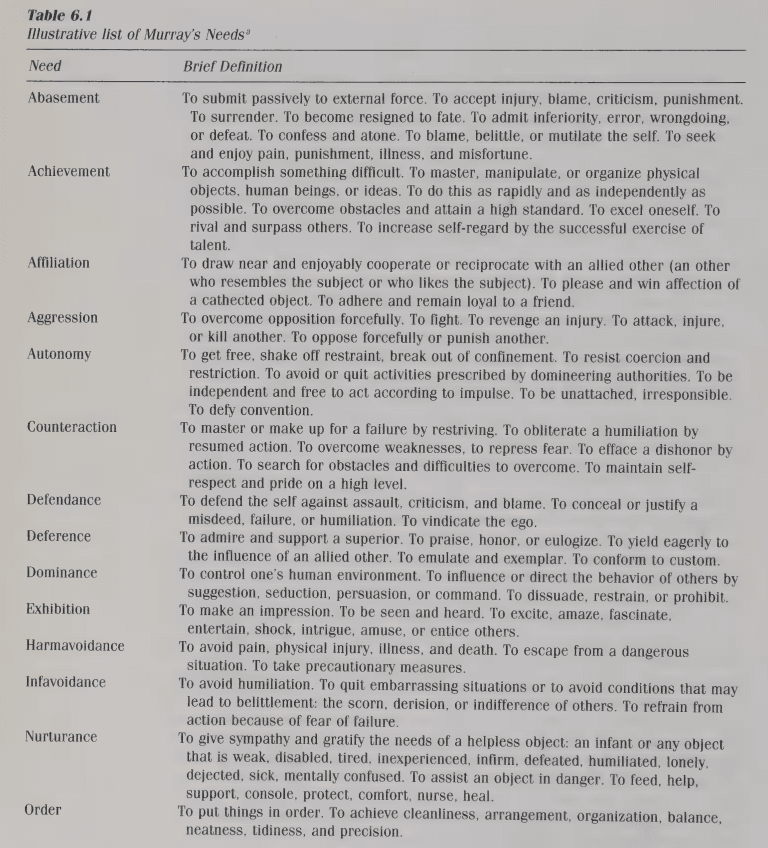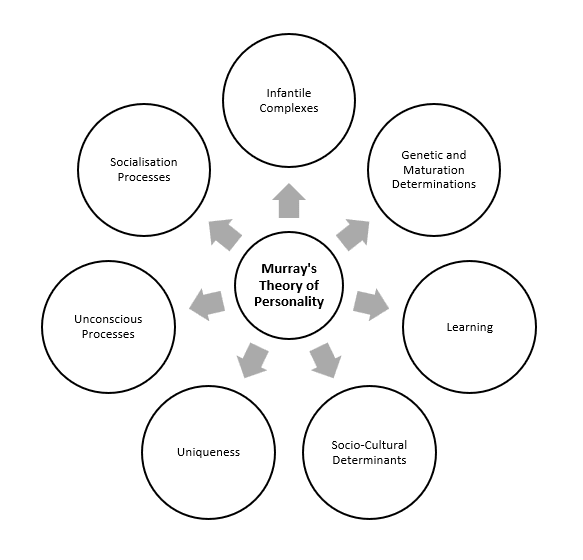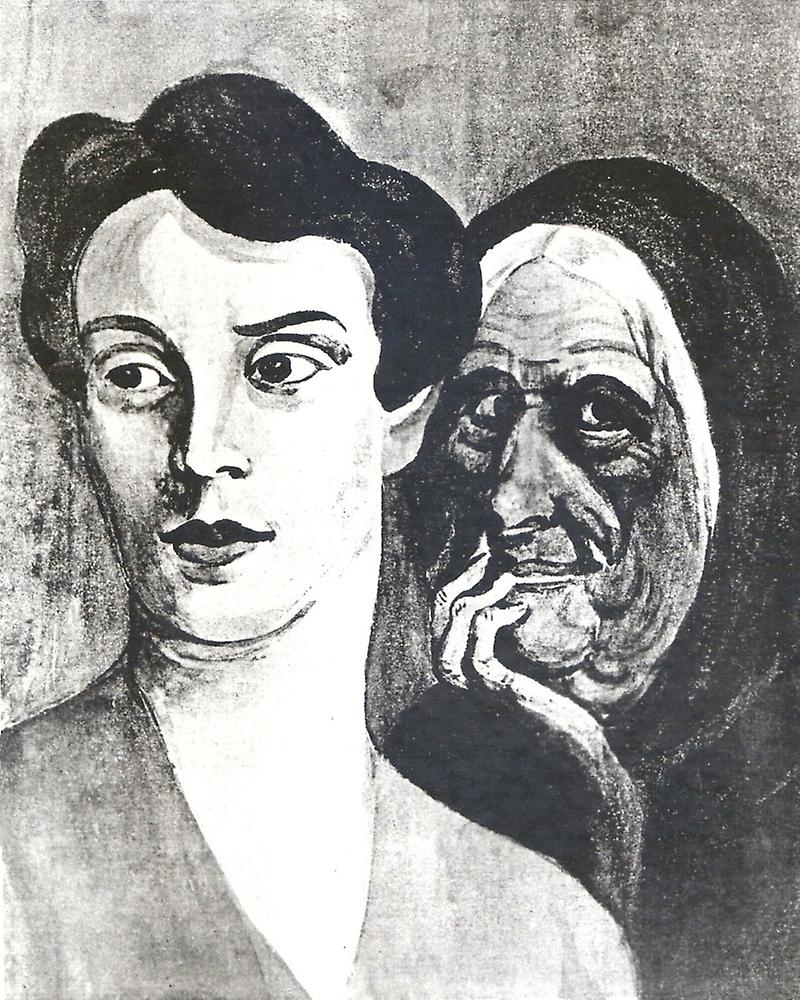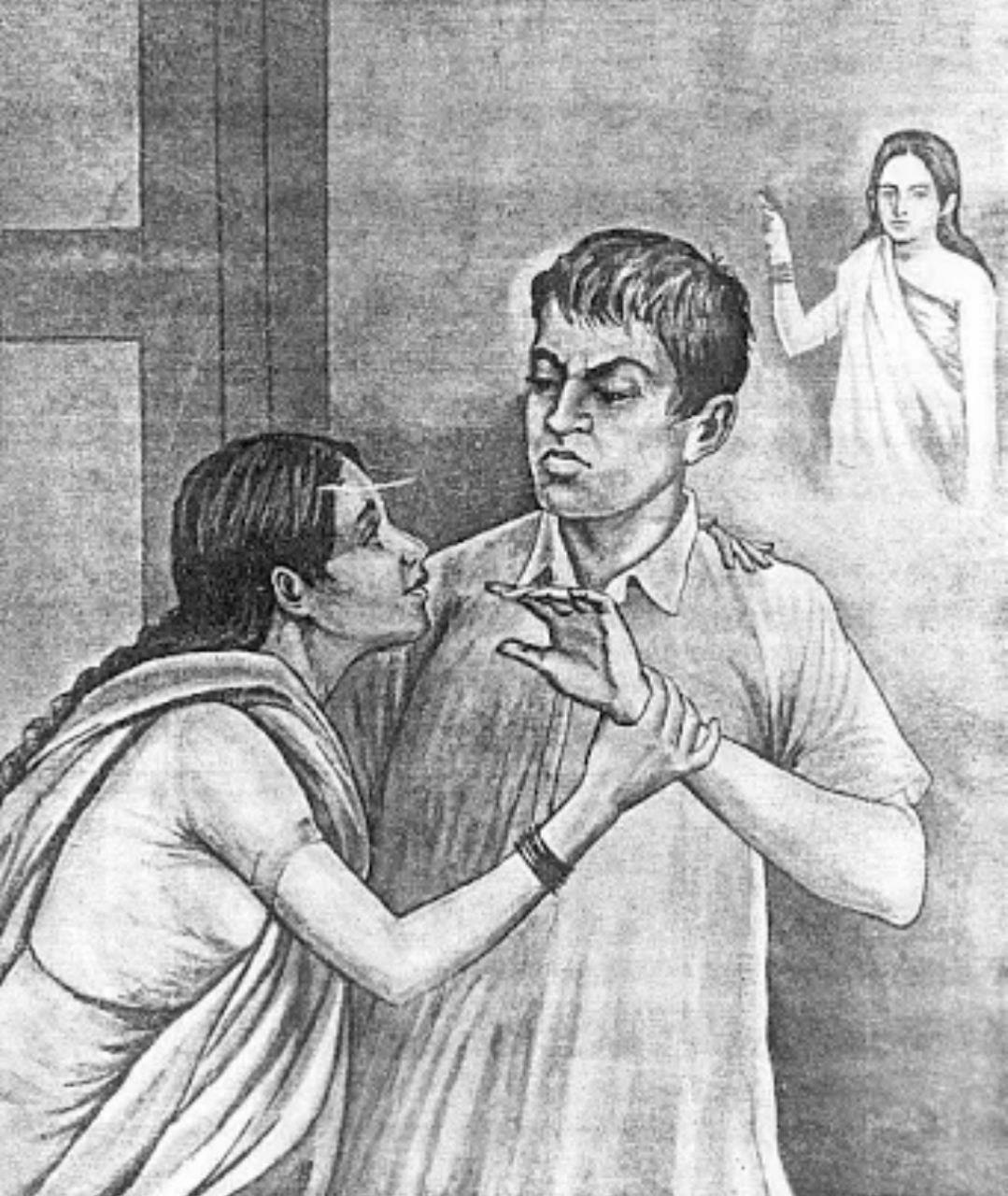Introduction to Murray’s Theory of Motivation
Murray’s theory of motivation is a comprehensive theory of motivation that explores the intricate dynamics between internal psychological needs and the external demands that individuals face in their environment. It was given by Henry Murray, an influential American psychologist born in 1893.
His approach, often referred to as the Needs-Press Theory, proposes that human behavior is not solely driven by internal desires or biological imperatives but by the interplay between these internal needs and external environmental factors. In Murray’s view, individuals are complex, dynamic, and continuously engaged with their surroundings, which shapes their behaviors and motivations.
Read More- Psychoanalysis
Needs and Press
Murray’s theory of motivation is based on the premise that human behavior is driven by a combination of internal psychological needs and external environmental pressures.
He defined needs as drives or desires that prompt individuals to engage in specific behaviors to satisfy those needs. Unlike physiological needs such as hunger or thirst, which arise from biological states.
Murray’s needs are psychogenic in nature, originating within the psyche. These needs include the desire for affiliation, achievement, autonomy, power, and many others, and are seen as fundamental motivators that shape individual behavior.
In addition to needs, Murray introduced the concept of press, which refers to the environmental factors or situational variables that influence how these needs are expressed and fulfilled. Press can either facilitate or inhibit the satisfaction of a need, depending on the circumstances.
For example, a challenging work task may activate a person’s need for achievement, while a supportive team environment may satisfy the need for affiliation.
Press, therefore, represents the external conditions that either help or hinder an individual’s ability to fulfill their internal needs. The dynamic interaction between needs and press, according to Murray, is what drives human behavior.
Types of Press
In Murray’s framework, press can be categorized into two types-
Alpha press
It refers to objective environmental conditions, such as the physical environment, social interactions, and cultural norms.
For example, a person working in a competitive industry may experience alpha press in the form of challenging tasks and high expectations, which could activate their need for achievement.
2. Beta Press,
It refers to the subjective interpretation of these environmental conditions. It involves how the individual perceives and reacts to external stimuli based on their personal experiences, expectations, and motivations.
For instance, a person may perceive a challenging work task as an opportunity for growth (beta press) or as a source of anxiety (beta press), depending on their individual characteristics and past experiences.
Psychogenic Needs
Murray’s identification of psychogenic needs was one of the central contributions of his theory. These needs are varied and numerous, and they serve as the basis for understanding how individuals are motivated to behave in different contexts. Among the most significant of these needs are-
- Affiliation- The need to be near others and engage in mutually enjoyable relationships.
- Autonomy- The need for independence and freedom from control or dependency on others.
- Achievement- The need for success, accomplishment, and the attainment of challenging goals.
- Dominance- The need to control or influence others.
- Exhibition- The need to be seen and heard, often manifested through behaviors aimed at entertaining or attracting attention.
- Harm-Avoidance- The need to avoid injury or danger, which prompts individuals to take precautions and act with caution in their daily lives.
- Nurturance- The need to care for and support others, particularly those who are weak, ill, or in need of help.
- Order- The need for organization, structure, and neatness.
- Play- The need for enjoyment, fun, and recreation.
- Sex- The need to form intimate, erotic relationships.
- Succorance- The need to be cared for, loved, or nurtured.
- Understanding- The need to analyze, speculate, and gain insight into the world around them.
These psychogenic needs are not static; they fluctuate in strength depending on the situation, individual experiences, and environmental influences. The interplay between these needs and the external press is what ultimately drives behavior. For instance- a person may experience a strong need for achievement in a work environment, but this need may be inhibited or facilitated by the challenges presented by their tasks or the support they receive from colleagues and superiors.

List of Presses
Read More- Motivation
Thema
In addition to needs and press, Murray introduced the concept of thema, which refers to an individual’s characteristic way of experiencing and expressing their needs. Thema is a unique, personal pattern of needs and behaviors that is influenced by a variety of factors, including upbringing, culture, and personal experiences. It represents an individual’s habitual ways of responding to environmental press and fulfilling their psychological needs.
For example- a person with a strong need for achievement might develop a thema where they continuously seek out challenging tasks and push themselves to excel in competitive environments. Alternatively, someone with a high need for affiliation might develop a thema where they prioritize social connections and seek environments that foster cooperation and mutual support. Thema can be thought of as an individual’s motivational blueprint, shaped by both their internal needs and the external press they encounter throughout their lives.
Murray’s Conception of Personality
Henry Murray viewed personality as a dynamic and integrated system that reflects the unique interplay between an individual’s internal psychological needs, environmental factors, and personal experiences. Unlike static trait-based approaches,
Murray emphasized that personality is fluid and evolves in response to situational demands and life circumstances (Murray, 1938). He proposed that personality is an organized structure where various components—biological, psychological, and social—work together to shape behavior.
Central to Murray’s conception of personality is the idea of needs, which represent internal drives that motivate individuals to act in particular ways. These psychogenic needs (e.g., achievement, affiliation, and autonomy) interact with external press—situational factors that can either facilitate or inhibit the satisfaction of these needs.
Hall and Lindzey (1978) summarised Murray’s definition of personality as follows-
- An individual’s personality is an abstraction formulated by the theorist and not merely a description of the individual’s behavior.
- An individual’s personality refers to a series of events that ideally span the person’s lifetime- “The history of the personality is the personality.”
- A definition of personality should reflect the enduring and recurring elements of behavior as well as the novel and unique.
- Personality is the organizing or governing agent of the individual. Its functions are to integrate the conflicts and constraints to which the individual is exposed, to satisfy the individual’s needs, and to make plans for the attainment of future goals.
- Personality is located in the brain: “No brain, no personality.”
The interplay between needs and press creates thema, or characteristic patterns of behavior that reflect an individual’s consistent way of navigating their environment. For example, someone with a strong need for achievement might consistently seek challenging tasks in their personal and professional life, but their success in fulfilling this need may depend on whether the environment provides adequate opportunities or poses significant barriers.

Murray’s Theory of Personality
Infantile Complexes
Murray drew from psychoanalytic theory to emphasize the lasting influence of early childhood experiences on personality. Infantile complexes, such as dependency, sibling rivalry, and the Oedipus complex, were seen as critical in shaping an individual’s motivations and behaviors. Hall and Lindzey (1978) highlight Murray’s view that these complexes are not merely obstacles to be overcome but are integral to the formation of enduring personality traits. For instance- an unresolved need for parental approval might evolve into a pronounced need for achievement or succorance in adulthood.
Genetic–Maturational Determinants
Murray acknowledged the foundational role of biological and genetic factors in personality development. He argued that these factors provide the raw material—such as temperamental predispositions and innate drives—that interacts with environmental influences. Hall and Lindzey (1978) note Murray’s alignment with evolutionary perspectives, recognizing the influence of genetic predispositions on traits like dominance, aggression, and nurturance. However, Murray was clear that these determinants do not act in isolation; rather, their expression is shaped by environmental and cultural contexts.
Learning
Murray emphasized the role of learning in the development of personality, particularly through reinforcement and observational processes. Experiences that satisfy or frustrate an individual’s needs contribute to the shaping of behavioral patterns over time. Hall and Lindzey (1978) underscore Murray’s departure from purely psychoanalytic or behavioral models, noting that he integrated both perspectives. For example- a child rewarded for demonstrating autonomy may develop a stronger need for independence, while a child punished for assertiveness might suppress their need for dominance.
Sociocultural Determinants
Murray recognized the profound impact of culture and society on personality. Sociocultural factors determine the press—external conditions—that influence how individuals express their needs. Hall and Lindzey (1978) describe Murray’s insights into how societal norms shape not only the opportunities available to individuals but also the desirability of specific traits. For example, the need for achievement might be celebrated in individualistic cultures but less emphasized in collectivist ones. Murray’s acknowledgment of cultural variability made his theory highly adaptable across different societal contexts.
Uniqueness
Central to Murray’s theory is the idea of individuality. He rejected one-size-fits-all explanations of personality, instead emphasizing that each person represents a unique combination of needs, press, and experiences. Hall and Lindzey (1978) praised this aspect of Murray’s work, noting that his insistence on studying individuals holistically provided a counterbalance to the era’s growing emphasis on group-level statistical analyses. This focus on uniqueness is reflected in Murray’s method of intensive case studies.
Unconscious Processes
While Murray embraced psychoanalytic principles, he expanded on Freud’s notion of the unconscious. He argued that unconscious processes are not limited to repressed desires but also include unacknowledged needs and habitual patterns of interpreting the world. Hall and Lindzey point out that Murray’s conceptualization of the unconscious was broader and more dynamic than traditional Freudian views, incorporating cognitive and motivational dimensions. For instance, an unconscious fear of failure might influence an individual’s need for achievement, driving them to set overly ambitious goals or avoid challenges altogether.
The Socialization Process
Murray viewed socialization as a critical mechanism through which personality is shaped and refined. Socialization teaches individuals how to satisfy their needs within the constraints of societal norms and expectations. Hall and Lindzey note that Murray’s theory of socialization bridges psychoanalytic and sociocultural perspectives. For instance, a child’s natural need for play may be encouraged through culturally sanctioned recreational activities, while their need for dominance may be moderated by lessons in cooperation and respect for authority.
Measuring Personality- TAT
The Thematic Apperception Test (TAT), developed by Henry A. Murray and Christiana Morgan in the 1930s, is a projective psychological tool designed to explore the unconscious motives, desires, and conflicts of an individual. By presenting ambiguous visual stimuli—usually a series of evocative black-and-white pictures—participants are encouraged to create stories, revealing their deeper psychological processes.
The TAT stems from Murray’s personality theory, particularly his concepts of needs, press, and thema. It operates on the principle of projection: when faced with ambiguous stimuli, individuals unconsciously project their inner conflicts, emotions, and motivations onto the imagery. This allows the examiner to infer dominant psychogenic needs (e.g., achievement, affiliation, dominance) and recurring patterns of thought and behavior.
The test comprises 31 cards depicting varied scenes involving people, objects, or abstract designs. Typically, 10–12 cards are selected and shown to the participant during a session. For each card, the participant is asked to construct a story answering questions like- What is happening? What led up to this moment? What will happen next? What are the characters thinking or feeling?

TAT Card
Interpretation focuses on themes, conflicts, and character dynamics within the stories. The analysis identifies how an individual’s internal needs interact with external environmental pressures. For example, a person with a strong need for achievement may construct stories about success against challenges.

TAT Indian Edition
While originally qualitative, various scoring systems have standardized TAT interpretations. The TAT is widely used in clinical, research, and occupational settings to assess personality dynamics, emotional conflicts, and social motives. Its ability to uncover unconscious processes makes it a unique and valuable tool, though its subjective nature requires skilled interpretation and has drawn both support and criticism over time.
Conclusion
Henry Murray’s theory of motivation provides a nuanced and comprehensive framework for understanding human behavior by emphasizing the interplay between internal psychological needs and external environmental factors. His Needs-Press Theory highlights that human motivation is not purely intrinsic or extrinsic but arises from the dynamic relationship between these two forces. By identifying psychogenic needs such as achievement, affiliation, and autonomy, and their interaction with situational press, Murray presented a flexible model that accounts for the variability of human behavior across different contexts.
References
Murray, H. A. (1938). Explorations in Personality. New York: Oxford University Press.
McClelland, D. C. (1985). Human Motivation. Cambridge: Cambridge University Press.
Hall, C. S., & Lindzey, G. (1978). Theories of Personality (3rd ed.). New York: Wiley.
Winter, D. G. (1996). Personality: Analysis and Interpretation of Lives. New York: McGraw-Hill.
Subscribe to Careershodh
Get the latest updates and insights.
Join 13,999 other subscribers!
Niwlikar, B. A. (2020, March 23). Murray’s Theory of Motivation- Discover 12 Important Psychogenic Needs. Careershodh. https://www.careershodh.com/murrays-theory-of-motivation/
